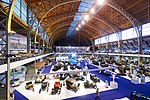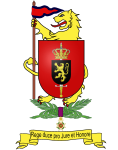Cinquantenaire
The Parc du Cinquantenaire (French for "Park of the Fiftieth Anniversary", pronounced [paʁk dy sɛ̃kɑ̃tnɛʁ]) or Jubelpark (Dutch for "Jubilee Park", pronounced [ˈjybəlpɑr(ə)k]) is a large public, urban park of 30 ha (74 acres) in the easternmost part of the European Quarter in Brussels, Belgium. Most buildings of the U-shaped complex which dominate the park were commissioned by the Belgian Government under the patronage of King Leopold II for the 1880 National Exhibition commemorating the 50th anniversary of the Belgian Revolution. During successive exhibitions in the same area, more structures were added. The centrepiece memorial arch, known as the Cinquantenaire Arch (French: Arc du Cinquantenaire, Dutch: Triomfboog van het Jubelpark), was erected in 1905, replacing a previous temporary version of the arcade by Gédéon Bordiau. The structures were built in iron, glass and stone, symbolising Belgium's economic and industrial performance. The surrounding 30 ha (74 acres) park esplanade was full of picturesque gardens, ponds and waterfalls. It housed several trade fairs, exhibitions and festivals at the beginning of the century. In 1930, the government decided to reserve the Cinquantenaire for use as a leisure park.The Royal Military Museum has been the sole tenant of the northern half of the complex since 1880. The southern half is occupied by the Art & History Museum and Autoworld vintage car museum. The Temple of Human Passions by Victor Horta, a remainder from 1886, the Monument to the Belgian Pioneers in Congo from 1921, and the Great Mosque of Brussels from 1978, are located in the north-western corner of the park (see map below). Line 1 of the Brussels Metro and the Belliard Tunnel from the Rue de la Loi/Wetstraat pass underneath the park, the latter partly in an open section in front of the arch. The nearest metro stations are Schuman to the west of the park, and Merode immediately to the east.
Excerpt from the Wikipedia article Cinquantenaire (License: CC BY-SA 3.0, Authors).Cinquantenaire
Porte de Tervueren - Tervuursepoort,
Geographical coordinates (GPS) Address Nearby Places Show on map
Geographical coordinates (GPS)
| Latitude | Longitude |
|---|---|
| N 50.840555555556 ° | E 4.3927777777778 ° |
Address
Tunnel Cinquantennaire - Eeuwfeesttunnel
Porte de Tervueren - Tervuursepoort
1040
Belgium
Open on Google Maps









